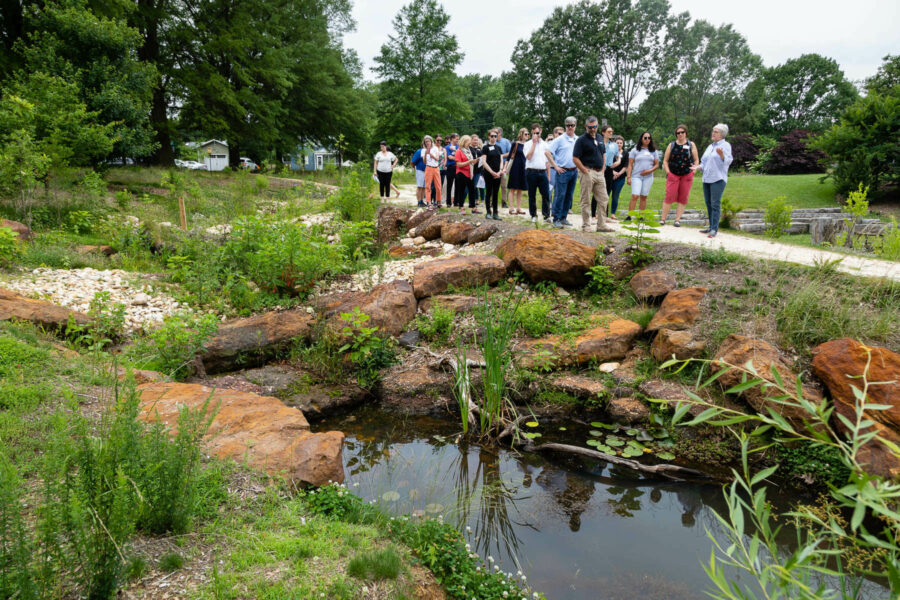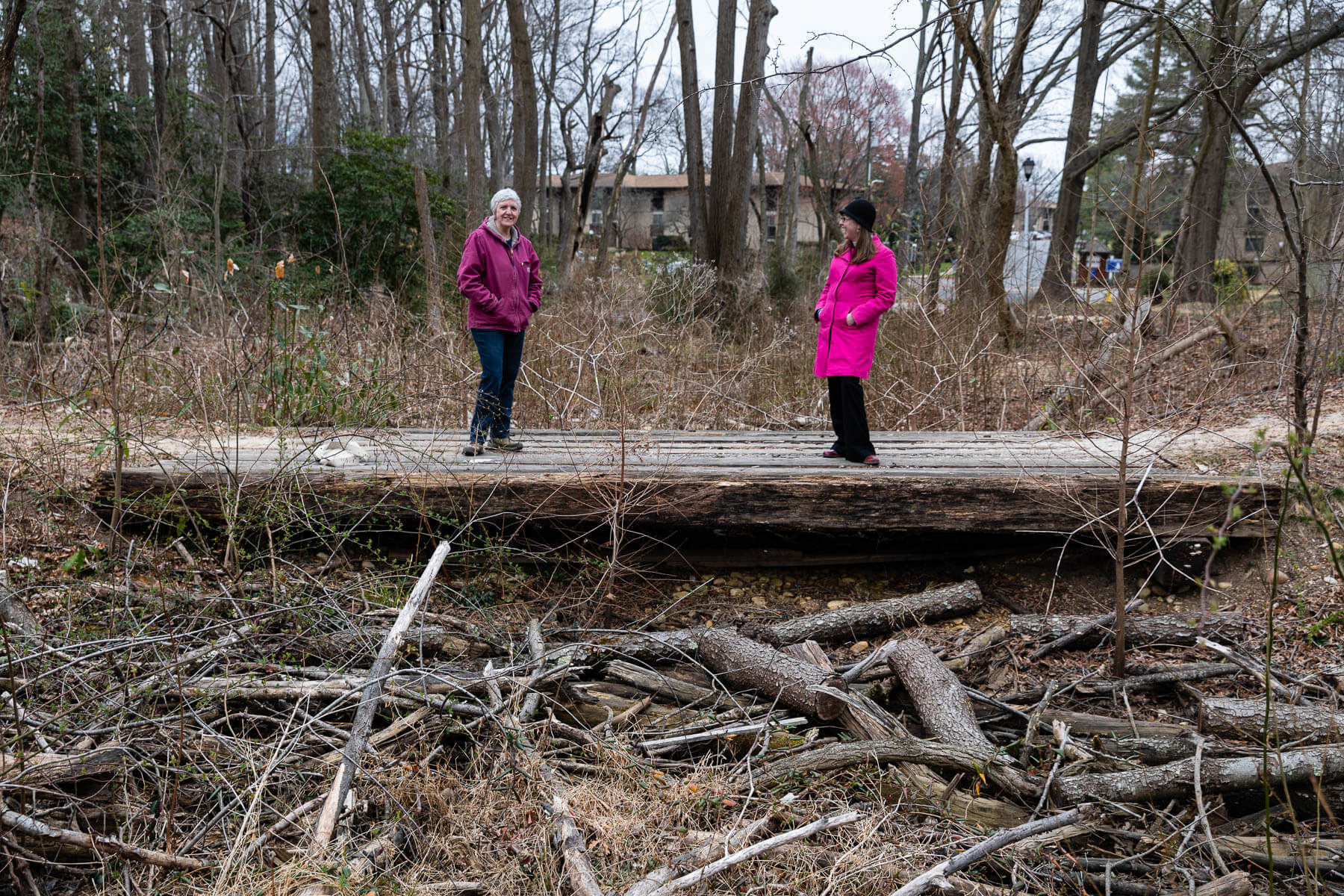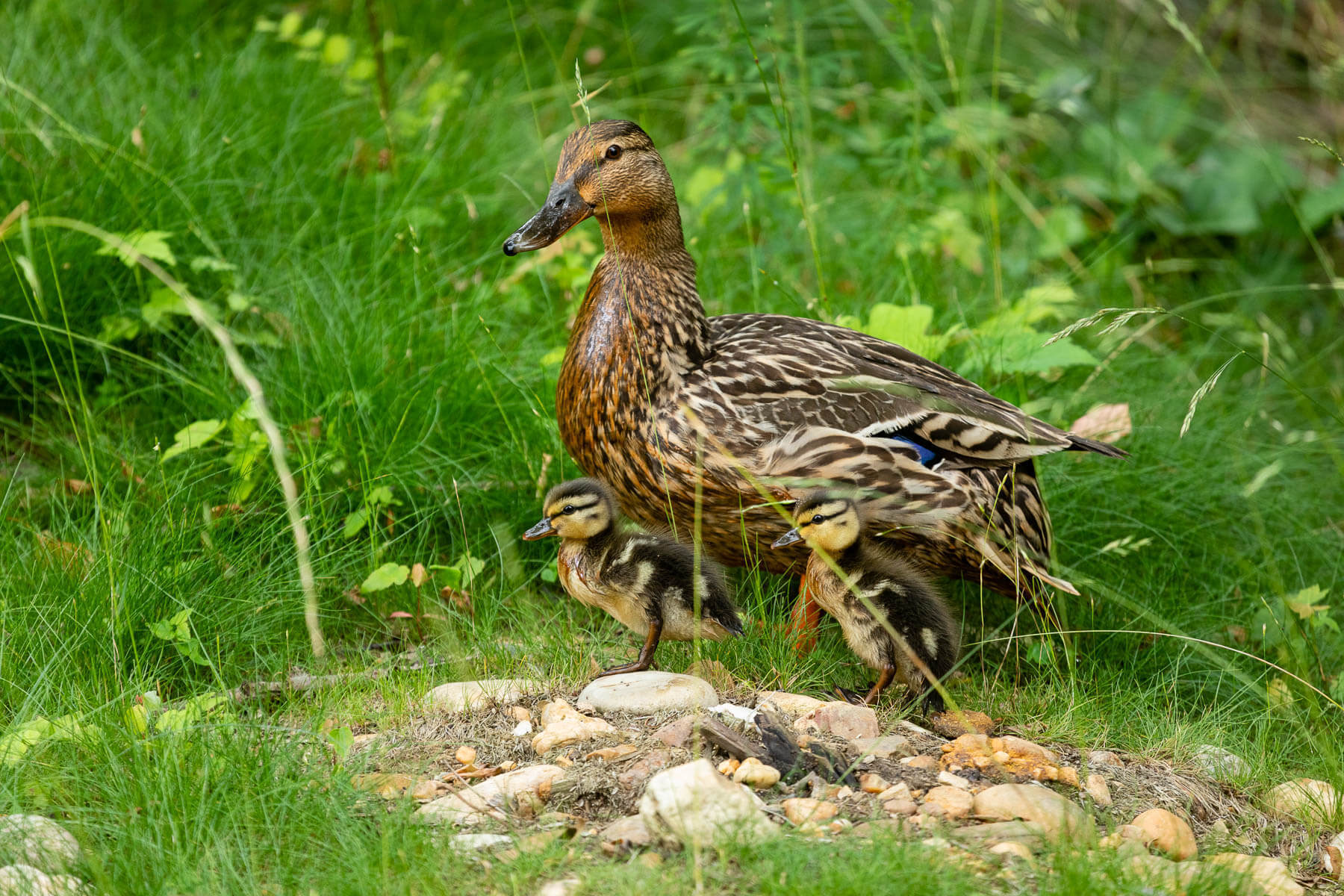Caring for creation
A restored stream at St. Luke's Episcopal Church is a beacon of environmental progress

On a fall day in 2018, members of St. Luke's Episcopal Church in Annapolis, Maryland gathered to celebrate a stream and shoreline restoration project on their property. They had planned to bless the stream with holy water, a tradition within the Episcopal Church, but then it started pouring rain.
“Looks like God got ahead of us,” said the Rt. Rev. Eugene Sutton, Bishop of the Episcopal Diocese of Maryland, of which St. Luke’s is a member.
You might think the downpour ruined the moment, but it was a blessing in disguise. In earlier years, severe rain would have flooded the church grounds, carrying loads of harmful sediment through the stormwater drain before emptying into Back Creek. But on the day of the celebration, the church’s new stream was a saving grace.
“In any other place it would have been a flood, but it was totally contained,” said Betsy Love, the church’s manager for the restoration project. “As the water left, our stream had no sediment—zip, zero, none.”
Not only that, but where the church property ends at Back Creek, a tributary of the Severn River, the new living shoreline and tidal marsh absorb flood tides when the town's city dock floods.
The rain allowed the congregation to marvel over the roaring stream. But it also gave the project’s two leading forces—Betsy Love and the Rev. Diana Carroll—an opportunity to reflect on all that was achieved by their small congregation.

Building back what was lost
The quarter-mile stream at St. Luke’s isn’t as much a restored stream as it is a replicated one.
Decades ago, the stream that once went through St. Luke’s property was buried underground within a stormwater pipe drainage system—a standard practice of the time that we now know causes excess nutrients and sediment to enter the tributary, causing ecological degradation. In its design, landscape architecture firm Underwood & Associates effectively brought the buried stream up to the surface and constructed a new streambed for it, a process known as “daylighting.”
Where there was once just mowed lawn and trees overgrown with invasive plants, a restored stream starts at the front of the property and weaves through an idyllic Chesapeake landscape filled with indigenous, coastal plain sandstone boulders and young cedar, oak and pine trees. The woods now include thousands of native plants, trees and a wetland frequented by frogs, hawks, foxes and other critters. Where the stream ends at Back Creek, a sandy shoreline is filled with spartina grasses, cattails, rushes and a cove frequented by ducks—a symbolically picturesque end to an ambitious project.
The environmental benefits are extensive. The stream uses large bioswales, cobble riffles and log weirs to capture stormwater from 28 acres of the surrounding city streets. Those features slow the water down so that it can more efficiently soak into the ground, replenishing the underground aquifer and improving soil conditions for plant life. The expanded wetland and forest enhances carbon sequestration, while new wildlife habitat is strengthening the food chain for birds, mammals and insects.
“We turned 28 acres of municipal pollution into clean water and quality habitat,” said Love, who can walk you through every scientific detail of the project.
Benefits to the congregation and the community were also central to the project, which now serves as an environmental literacy campus, with signage, an amphitheater and public trails that follow the stream. The church teaches environmental courses and shows students what a healthy ecosystem looks like, and it plans to partner with community groups and host a variety of outdoor events focused on connecting people with the environment.

The scale of the project, totaling $1.5 million, was daunting for such a small congregation with limited resources for infrastructure.
“It’s equivalent to building another building,” said Carroll, who has been shepherding the project since it began in 2013.
Love, Carroll and other church members held fundraisers, secured permits, hired partners and found a way around every logistical hurdle that came their way. It was Love who first noticed how the stormwater system was polluting Back Creek, and with support from the church, consulted local watershed experts, enrolled in the Anne Arundel Watershed Stewards Academy and then presented a design concept during her training, which caught the attention of RiverWise Congregations.
Partners of RiverWise Congregations, who eventually funded the initial design and permitting, include Interfaith Partners for the Chesapeake (IPC), the Watershed Stewards Academy, Maryland Department of Natural Resources (DNR) and the Chesapeake Bay Trust (CBT). Further funding for construction was provided by DNR and the Atlantic Coastal Bays Trust Fund, while the Episcopal Church’s United Thank Offering funded the environmental literacy campus features. Additional funding for the design/permitting cost was provided by a Chesapeake Bay Trust WAGP award. And to manage the extensive budget, St. Luke’s partnered with The Alliance for the Chesapeake Bay.
“We are fortunate to have had such quality organizations as partners with highly accomplished individuals on staff,” said Love. “They advised, educated, networked and empowered us.”
Living up to their mission
One of the four tenets guiding St. Luke's Episcopal Church is “Caring for God’s Creation.” Having been blessed with a property so close to a Chesapeake Bay river, the church has the privilege of truly living up to that aspect of their mission.
“As an Episcopal congregation, we believe that caring for God's creation is an essential part of living a faithful Christian life,” Carroll said. “We are not separate from the rest of creation, but part of it, and our role as humans is to tend the earth that God has made and entrusted to our care.
Religious groups throughout the Chesapeake Bay watershed have an opportunity to steward their land just as St. Luke’s has done. Churches, synagogues, mosques and all other faith-based centers tend to have green space where they can plant pollinator gardens, trees and conservation areas. Depending on the size and makeup of their property, they can also manage forest, stream or shoreline habitats.
“Partnering with congregations is critical to accelerating clean-water work on the ground,” said Kate Fritz, Chief Executive Officer at the Alliance for the Chesapeake Bay. “The reach of a congregation means more people become involved and educated on ways that they can care for creation, both at their house of worship and on their own property."
According to Love, the church has inspired other projects in the Annapolis area, including the Annapolis Maritime Museum’s living shoreline project and Anne Arundel County SPCA’s upcoming watershed and living shoreline restoration (which Love is the project manager for). Love and the Severn Riverkeeper Program are also working with another community, Mariner’s Point, to combine the two projects into a Back Creek Headwaters Project.
Back at the church, thriving wildlife offers subtle proof of the project's success. One sign of a healthy Chesapeake waterway is the return of frogs, and at St. Luke’s, each spring now brings a chorus of croaks.
“When those frogs start singing,” said Love, “It’s like God is singing.”

Comments
There are no comments.
Thank you!
Your comment has been received. Before it can be published, the comment will be reviewed by our team to ensure it adheres with our rules of engagement.
Back to recent stories